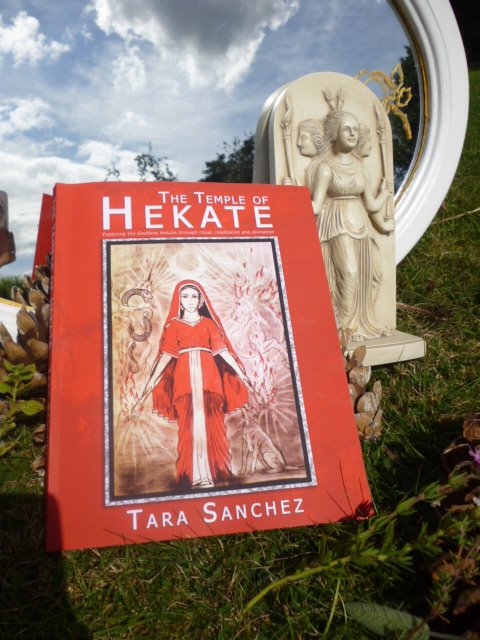Not all the material I wrote made it into my book some bits didn’t make the grade and were left out, one of them was the concept of a Hekate related calender, after a debate with a fellow Covenant of Hekate member this evening, I thought it was time to post up one of the sections that didn’t get included as it may help others in thier journeys, I do hope you enjoy it.
The Attic Calendar
“All-coloured Horae, rich increase your care, circling, forever flourishing and fair”
We briefly touched upon the subject of the Attic Calendar in the chapter for divination, as it is the Hellenic calendar which has survived in the most complete format, it is appropriate to use this upon which to base a ritual year. The months as has been explained before do not correlate directly to the months in the modern calendar as we understand it, and it is this common misconception that leads to comments like “the 13th of August is sacred to Hekate”, which undoubtedly came a about as a result of the 30th of the Month (Deipnon) falling upon August 13th rather than the actual date of the 13th being sacred.
The Dance of the Horae
The Horae or seasons of ancient mythology were originally just two, spring/summer & autumn/winter, however over the centuries this grew, the a large majority of writers named them as three and artwork of three seasons is quite common, these seasons correlating to Spring and new growth after a fallow period, Summer when the fruits and beans were in season and Autumn when the grain crops were ready for harvest. This can also cause some confusion for the seasons in the Mediterranean do not correlate accurately into a Celtic Northern European wheel of the year, the fallow period was considered to be during what we would know as midsummer, for this was a time of drought, with the planting of wheat happening later in the year when the first rains arrived sometimes as late as November or December by our reckoning, and then harvested in May or June, as a result Persephone’s decent into the underworld for example would be most fitting on or around the summer solstice, not the winter, and rites that you may choose to create around this mythology involving Hekate should reflect this.
Provided below is a list of the Attic months, and other information such as known dates of festivals to Hekate or associated deities which can be used to create a more complete ritual cycle2, in cases where a festival or mystery rite took longer than one day, such as the lesser mysteries during Anthesterion, a shorter 2 day period has been indicated for modern usage; Also for convenience sake modern seasons have been included but traditional festivals have retained their rightful place in the dance of the Horae as it would have been.
|
Attic
|
Gregorian
|
Festival
|
|
Hecatombaion
|
Jul – Aug
|
- Noumenia
30 Deipnon
|
|
Metageitnion
|
Aug – Sept
|
- Noumenia
16 Sacrifice – Kourotrophos, Hekate, Artemis
30 Deipnon
|
|
Boedromion
|
Sept – Oct
|
1 Noumenia
20 Greater Mysteries
21 Greater Mysteries
30 Deipnon
|
|
Pyanopsion
|
Oct – Nov
|
- Noumenia
30 Deipnon
|
|
Maimakterion
|
Nov – Dec
|
- Noumenia
30 Deipnon
|
|
Posiedeon
|
Dec – Jan
|
1 Noumenia
26 Haloa
30 Deipnon
|
|
Gamelion
|
Jan – Feb
|
1 Noumenia
27 Sacrifice – Kourotrophos, Hera ,Zeus, Teleius, Poseidon.
30 Deipnon
|
|
Anthesterion
|
Feb – Mar
|
- Noumenia
12 Anthesteria Khoes
20 Lesser Mysteries
21 Lesser Mysteries
30 Deipnon
|
|
Elaphebolion
|
Mar – Apr
|
- Noumenia
30 Deipnon
|
|
Mounichion
|
Apr – May
|
- Noumenia
6 Didymeia
30 Deipnon
|
|
Thargelion
|
May – Jun
|
- Noumenia
19 Bendidea
30 Deipnon
|
|
Skirophorion
|
Jun – July
|
1 Noumenia
3 Sacrifice – Kourotrophos, Athene, Polias, Aglaurus, Zeus, Polieus, Poseidon, Pandrosos.
30 Deipnon
|
Noumenia – The first day of the new moon and of the new month, this was associated with Hekate through the works of Pindar who said that Hekate gave omens of victory on the 1st day of the Month, this day is a particularly fortuitous day to perform works of divination at dawn, oracular work and skrying can also incorporated into the rite. As the start of a new month this is a good time to perform devotional work and a reaffirmation of your dedication to the Goddess in the coming month.
Sacrifice to Kourotrophos – This sacrifice happens during 3 months of the yearly cycle, Metageitnion, Gamelion, Skirophorion, and although only one specifically names Hekate, the epithet of Kourotrophos appears in all these festivals which make them appropriate to celebrate for you can evoke Hekate in that aspect, in addition you may wish to also evoke, Artemis and Zeus as appropriate. As they are relatively evenly spaced throughout the year and are an excellent time for topping up defences around the home petitioning the Goddess to protect it, and its inhabitants, particularly children, records show that a suitable sacrifice for the Goddess at these times were pigs, as many today may not wish to handle pork (or any meat) products creating a votive offering in the image of a pig and immolating it would be another alternative to consider, do however make sure you inscribe it and dedicate it to Hekate. If at all possible try and make this rite in the month of Metageitnion coincident with a clear night when it may be possible to witness the Perseid meteor showers, which are named after Hekate’s father.
Greater Mysteries – These are the mysteries of Demeter and Persephone at Eleusis, in which not only was Hekate perceived to guide the Mystai with Iakkos, but also when she became companion and guide to Persephone. This is a most fortuitous time for rites of self dedication and initiation, it should be marked annually with a day of fasting (or abstinence) followed by a night time vigil or procession celebrating Hekate in her aspect of torchbearer and light bringer. This is also a time for making reparations over past wrong doings, and offering the olive branch to would be enemies, clearing the slate and stating anew.
Haloa – Whilst for a us a midwinter festival, this would have been a festival of growth in the Mediterranean world, it was considered a time of feasting and thanks marked with bonfires and banquets and an all night vigil to greet the rising sun, as this falls so very close to Yule and Christmas, it would be more than acceptable to perform this rite on a solstice night, evoking Hekate and inviting her to attend a feast in her honour which should be contained within the ritual circle, Reif3 does suggest that this may have been a “women’s only” rite of a rather bawdy nature, think hen party and then some, so you may like to consider telling the males in your group to find a quiet pub to spend the night in for this one, after all we don’t really wanting them to know “all” the women’s mysteries now do we girls?
Anthesteria Khoes – The Attic equivalent of the day of the dead, the God Hermes in his role of psychopomp was honoured on this night, when the spirits of the dead were said to wander abroad. This is an excellent night to honour both Hermes and Hekate together as well as honouring ancestors and those who have passed with a dumb supper rite, the records note that casseroles with root vegetable were offered most probably because they grew underground.
Lesser Mysteries – All initiates of the Greater mysteries first had to undergo the lesser mysteries and these took place every four years, the gods honoured during these rites were traditionally Demeter, Persephone and Dionysus and was considered by some to be the nuptial celebration of the divine couple; this is an excellent time for performing rites of blessing, both upon relationships, but also new ventures, homes and welcoming family into the fold both magickal and physical. Within that remit it is worth evoking Hekate alongside the deities mentioned above, especially considering her close connection with the greater mysteries. This would also be a time for prospective initiates to request initiation at the following Greater Mysteries and dedicate to the period of study required to undergo such a rite.
Didymeia – This was an annual Pythian rite to Apollo held in the town of Miletus in Caria, the date is ambiguous, but some academics have surmised that it took place in the Milesian month of Taureon, which is believed to have occurred some two months after Anthesterion, this date would correlate for the rite was sacred to Apollo and this date ties in with the Attic date which is recognised as Apollo’s birthday. During this rite two large stone cubes were placed before “Hekate at the Gate”; during this ritual, temples both astral and physical should be cleansed, magickal protections should be reinforced and divination should occur to ascertain the direction of your work (or groups work) during the following year.
Bendidea – The annual rite of the Thracian Goddess Bendis mentioned by Plato in his work Republic, it was considered quite a spectacle and involved horseracing by torch light through the streets of Athens. Whilst it appears that the original rites were one of purification and solemnity, they eventually because fairly bawdy raucous affairs, if working in a group, this might be a suitable ritual for the gentlemen to get all down and dirty with the men’s mysteries, you know, beer, wine, song, curry etc. etc. Competitions both physical and mental could also be incorporated into this rite.
Deipnon – Performed monthly during the dark moon the Deipnon was primarily about cleansing, and petitioning Hekate to keep the house safe during the coming months, because of the offerings given it eventually became a time for charity for the poor it was said, fed from the suppers laid out on the crossroads for Hekate. Suitable offerings would be eggs, garlic, fish, honey and cheesecakes, which should be placed outside separately from the cleansings of the home. It is a good time to perform physical cleansing as well as magickal cleansing, make sure all tasks that need to be done such as any outstanding obligations, household or work related paperwork etc. In fact any ends you want to tie up should be done so before performing this rite.
————————-
1 Orphic Hymn to the Horae
2 Festival Dates taken from http://www.numachi.com/~ccount/hmepa/
3 Reif, J. Mysteries of Demeter



 So I did promise you a post about my recent eye surgery and this morning seems like a good time to write it; I woke early, before it was even daylight and sat on my doorstep drinking a coffee, the moon very low and very golden watching over me. I can see her still even though dawn is now upon me, over my shoulder through my office window.
So I did promise you a post about my recent eye surgery and this morning seems like a good time to write it; I woke early, before it was even daylight and sat on my doorstep drinking a coffee, the moon very low and very golden watching over me. I can see her still even though dawn is now upon me, over my shoulder through my office window.